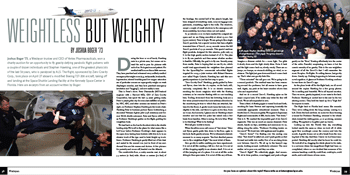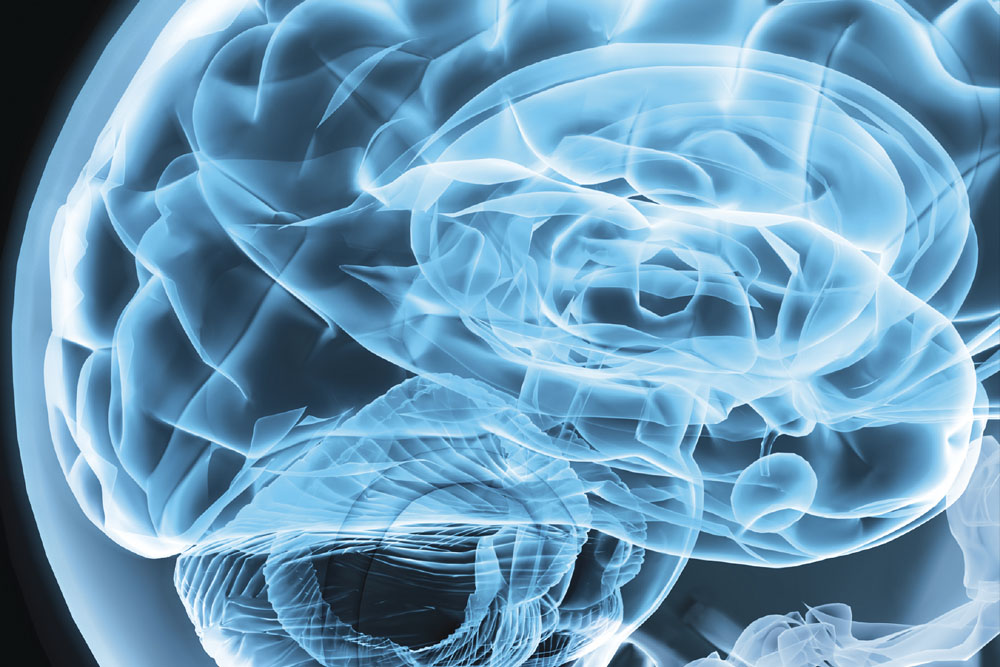Weightless But Weighty
Joshua Boger ’73, a Wesleyan trustee and CEO of Vertex Pharmaceuticals, won a charity auction for an opportunity to fly gravity-defying parabolic flight patterns with a couple of dozen individuals and Stephen Hawking, one of the greatest physicists of the last 50 years, who is paralyzed by ALS. The flight, sponsored by Zero Gravity Corp., took place on April 27 aboard a modified Boeing 727-200 aircraft, taking off and landing at the Space Shuttle Landing Facility at the Kennedy Space Center in Florida. Here are excerpts from an account written by Boger:
 During the hour or so of lunch, Hawking rests in a private area, but comes out toward the end to pose for pictures with each of us. He is gracious and patient. His medical staff is more than a little nervous. They have practiced and rehearsed every unlikely medical emergency that might occur (e.g., tachycardia, bradycardia, hypotension; slowed breathing and low oxygen saturation are of particular concern as super-gravity weighs on weak diaphragm muscles, and they have practiced emergency intubation and “bagging”), and now reality is near.
During the hour or so of lunch, Hawking rests in a private area, but comes out toward the end to pose for pictures with each of us. He is gracious and patient. His medical staff is more than a little nervous. They have practiced and rehearsed every unlikely medical emergency that might occur (e.g., tachycardia, bradycardia, hypotension; slowed breathing and low oxygen saturation are of particular concern as super-gravity weighs on weak diaphragm muscles, and they have practiced emergency intubation and “bagging”), and now reality is near.
This is Peter’s show. Peter Diamandis (MIT-trained engineer with a Harvard MD), CEO of Zero Gravity Corporation, has spent the last 14 years getting ready. Peter is playing this day for every last milliliter of publicity. NBC, ABC, and other cameras are trained on Peter’s right, on Professor Stephen Hawking in his iconic chair. Flanking Peter is business partner Byron Lichtenberg, a decorated Vietnam fighter pilot (238 missions) and former NASA shuttle astronaut. Peter and Byron will serve as Professor Hawking’s guides on the flight, guiding his weightless body.
We load back on the bus for the short ride to the shuttle landing strip.We’re all in the plane for what seems like a half hour before Professor Hawking’s chair appears in the open door, having been hoisted, with him in it, in an elevator truck of the type used to hoist freight up to airliners. Professor Hawking is gently lifted out of his chair and seated in the second row, just in front of my seat. Around him are his nurses and doctors. A few pictures for posterity and we are off, headed over the Atlantic.
The comfortable floor, a cushy exercise mat, is about 3.3 meters (11 feet) wide. About 21 meters (70 feet) of the fuselage, the central half of the plane’s length, has been stripped of everything: seats, carry-on luggage compartments, everything, right to the walls. The windows, except a couple of small windows in the emergency exit doors amidship, have been taken out and sealed.
In 30 minutes or so we have reached the assigned airspace and we are flying smoothly at about 15,000 feet (4,500 meters). Time to begin. We are going to fly a single Zero-G parabola, but a special version that has a slightly truncated time of Zero-G, 20–25 seconds versus the full Zero-G parabola of 25–30 seconds. This special cautious flight parabola, designed for this mission, pulls only 1.5 G in the high gravity section instead of 1.8 G. The plan is to fly one parabola and then assess whether another is feasible. Officially, the goal is to fly one. Secretly, away from media, Peter is hoping that we can fly six, which would total approximately the weightless time planned for the SpaceShipTwo commercial sub-orbital flights targeted for 2009, a joint venture with Richard Branson now called Virgin Galactic. Hawking has said this zero gravity experience is just his first step to space.
“Zero Gravity One!” Hawking, gently guided by Peter and Byron, rises into the air, supine, on his back, still, curiously, completely flat. It is an electric moment, mocking the classic magician trick with the floating assistant, as he remains floating with no one touching him. Trailing downward from his levitating body are a few wires (aimed toward that now-arbitrary direction by the monitoring devices to which they are attached, fastened to the floor). A gentle touch turns his body ever so slightly to the side, and there is a grin on his face, from ear to ear. And serenity. I glance over at Hawking’s heart monitor and see that his pulse has raised only a few beats from baseline. Mine is racing. He is in bliss. What is he thinking? What is he feeling?
We’d all give worlds to know.
When the all-too-soon call comes of “feet down,” Peter and Byron gently guide him down to the floor, again to his back. Earth gravity returns. We’ve witnessed a historic moment in so many respects: “the first disabled person ever to fly a weightless flight,” the most trivial of these.
Zero gravity is unlike anything you have experienced. It is not at all like cresting a hill in a fast car. It is not at all like dropping rapidly in an elevator shaft. It is not at all like jumping out of a plane. It is not at all like scuba diving in blue open water. It is not at all like any of these. Imagine a dimmer switch for a room light. You glide it slowly down and the light slowly dims. Raise it back and the light comes back on, slowly, evenly. There are no jumps, no bumps, no stomach shifting, no wind, no resistance. The light just goes down and then it comes back up. That’s what zero gravity feels like.
“Three minutes!” the call goes out. We’re going to do a second parabola. The medical team has been swarming around the professor, but all seems to have gone well. Again, my peek at the heart monitor shows him calm and unperturbed.
And we do a second Zero-G. Hawking spins on his major corporal axis. If he smiles any wider his face will break. We are all suspended in awe.
Then a third. A floating apple is tossed back and forth, mocking Sir Isaac Newton and capturing iconically the cosmically appropriate educational moment. Then a fourth Zero-G. Everyone is giddy. We regress to Superman flights and somersaults. A fifth. And a sixth. “Feet down.” This is it. We reached the impossible goal of six Zero-G segments. This was as much as anyone dreamed. Peter stands, hands on hips, amidship and announces to us, sitting along the cabin, “Professor Hawking insists on two more!” We break into wild applause and laughter.
“Zero-G Seven!” I’m floating over the seating area when “Feet down” is called out, and I push gently 20 feet forward and settle into reality. Few of us are lying down now between Zero-G’s. We sit up in the heavy-G segments, looking around, vestibularly coherent. The crew smiles: we’re pros now, and they can relax.
“Zero-G Eight!” We collectively giggle. And mourn.We sit in lotus position, cross-legged, and push a finger gently on the “floor,” floating effortlessly into the center of the cabin. Peaceful, unspinning, we learn at last the cosmic serenity of no gravity. This is the one weightless segment of all the Zero-G’s that I will remember the most. No spins. No flights. No ceiling dances. Just gravity down. Gravity up. Nothing happening in between except novel cognition. A glance at Professor Hawking confirms he was there six Zero-G’s ago.
As the plane levels off for the flight back, we all crowd around the supine Hawking for a few group photos. He is smiling and beautiful. We’re all beyond emotion. Then we move, gravity impaired, to our seats in the back. Professor Hawking is carried last to his seat by his two adoring nurses. They hold his hand up for a “high five” for anyone in reach.
The flight back to Florida land seems like seconds. Then we’re rolling down the long runway, coming to a halt. Down the back exit first, we make two lines forming a tunnel for Professor Hawking, returned to his wheelchair, toward the waiting press, 30 or 40 strong, cameras rolling. We applaud as he glides past us, heroic.
Looking up into the Florida blue sky, everything looked exactly the same as when we took off. A white egret flew mockingly across the runway and into the marsh. A gentle breeze cut us all a break from the waning heat of the day. And then I knew: we had been transported. Hawking did exactly what he knew he could do. He took all of us, dragging the whole planet in his wake, to a universe where his magnificent flight had been accomplished, where no one doubted that someone of his extreme handicap could fly, could float, could spin, could smile, and could dream of even more.

